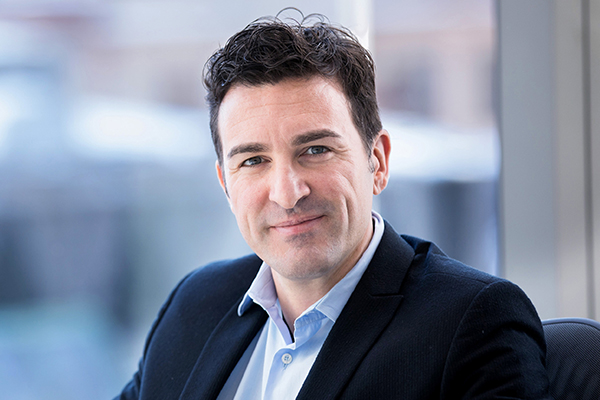Shire champions people around the world who struggle with rare diseases—an estimated 350 million patients. Up to 40 percent of these individuals are misdiagnosed more than once during the average five years it takes to correctly identify their illnesses. About half are children. To address those challenges, Gabriele Ricci leads Shire’s digital health and emerging technology team, which has a mission to not only create new capabilities, but also to help nurture a new mind-set focused on inspired digital transformation. “We’re creating tools that open doors to new discoveries that benefit our patients,” Ricci explains. “They are at the center of everything we do.”
Ricci’s team was formed when the company merged with Baxalta in June of 2016. That decision has helped Shire develop and harness innovations that are driving better patient outcomes and helping to keep pace with a rapidly changing healthcare landscape. To create the environment where that kind of leading-edge development happens, Ricci and his team are focused on several core activities.

First, they evangelize emerging trends that apply to Shire’s products and business goals by educating business partners on the value those opportunities offer. The team also consults on structured frameworks that can contribute to successful new technology investments. Lastly, the team brokers partnerships among internal staff and outside players; this includes scouting startups, working with R&D departments of technology partners, partnering with digital health accelerators, and nurturing relationships with universities and other academic institutions.
The team also does extensive internal education and coaching. It recently trained more than five hundred colleagues on advanced analytics, including data discovery, machine learning, and graph technology. This resulted in a twenty-five-fold increase in active users on the company’s advanced analytics framework within just four months. Its efforts also generated more than twenty new leads for artificial intelligence applications in R&D, technical operations, and commercial and corporate services.
“Laying the groundwork for a digital transformation is really more of a shift in mind-set and capabilities than it is adopting new technology,” Ricci says. “Our job is to create that mind-set and to raise awareness of the benefits that appropriately applied technology can bring to every part of our business.”
Part of the shift is changing how Shire goes about fueling innovation. Ricci and his team have developed an innovation accelerator framework that welcomes input from the business to help address specific challenges. This crowdsourcing approach is currently being used to improve operations in some of the company’s manufacturing plants.
The digital health and emerging technology team has also developed a tool kit that is used for day-and-a-half long ideation sessions. The kit supports the workshops with a structured design methodology that uses predefined materials and challenges to step through phases of discovery, definition, inspiration, creation, commitment, activation, and operation.
With up to fifty participants per session, they have already produced tangible results. An insight cockpit was developed that identifies business benefits by combining all commercial analytics into one platform. After a successful pilot, an Internet of Things (IoT) for labs has become the standard for lab equipment management across the enterprise.
As product innovations are piloted and refined, Ricci then focuses on developing business cases that will help integrate them into standard operations.
“We collect as much information as possible about real-world behaviors and scenarios to create comprehensive patient personas,” Ricci explains. “The resulting journey maps help us identify ‘moments that matter’ so we can deliver the most useful solutions to patients, caregivers, healthcare professionals, payers, and providers.”
The Shire Data Marketplace is an internal innovation that is improving the management, development, and accessibility of business intelligence and other resources. The stack is enriched with machine learning, data discovery tools, cognitive services, and new integration capabilities. As a result, it helps identify who is using available data and how the data is being used, and recommends other related data sets. It can even harvest information from IoT sensors, link those data sets into other data assets, and create new resources, like self-service dashboards.
Other developing technologies are being explored to facilitate additional new breakthroughs in the very near future. Artificial intelligence has the ability to affect patient outcomes by reducing the time to diagnosis, creating a better understanding of disease progression, offering behavior modification support, and improving market access through digital channels. Blockchain is being harnessed for outcome-based payments and traceability, while simultaneously enabling patients to better control their health records. Mixed reality will connect healthcare providers to important information on rare disease symptoms, treatments, and continuing education. Invisible sensor technology is expected to help create minimally intrusive clinical settings that more realistically duplicate patients’
real-world environments.
Eventually, Ricci believes that Shire will outgrow the need for his department. “When the digital mind-set permeates the organization and is part of its DNA, we won’t need a group dedicated to focusing on it any longer,” he says. “It will simply be an unconscious part of our values, behaviors, and operations and completely embedded in how we engage with our patients.”

